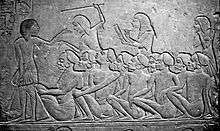Slavery in ancient Egypt

Slavery in ancient Egypt existed at least since the New Kingdom (1550-1175 BC). Discussions of slavery in Pharaonic Egypt are complicated by terminology used by the Egyptians to refer to different classes of servitude over the course of dynastic history. Interpretation of the textual evidence of classes of slaves in ancient Egypt has been difficult to differentiate by word usage alone.[1] There were three types of enslavement in Ancient Egypt: chattel slavery, bonded labor, and forced labor.[2][3][4]
Chattel slavery
Chattel slaves were mostly captives of war. All captives, including civilians not a part of the military forces, become a royal resource. The pharaoh would then resettle the captives by moving them into colonies for labour, giving them to temples, giving them as rewards to deserving individuals, and giving them to his soldiers as booty. Some chattel slaves began as free people who were found guilty of committing illicit acts and were forced to give up their freedom. Other chattel slaves were born into the life from a slave mother.[5]
Bonded laborers
Ancient Egyptians were able to sell themselves into slavery in a form of bonded labor. Selfsale into servitude was not always a choice made by the individuals’ free will, but rather a result of individuals who were unable to pay off their debts.[6] The creditor would wipe the debt by acquiring the individual who was in debt as a slave, along with his children and wife. The debtor would also have to give up all that was owned. Peasants were also able to sell themselves into slavery for food or shelter.[3][4]
Forced labor
Several departments in the Ancient Egyptian government were able to draft workers from the general population to work for the state with a corvée labor system. The laborers were conscripted for projects such as military expeditions, mining, quarrying, the building of pyramids, and other construction projects for the state. These slaves were paid a wage, depending on their skill level and social status for their work. Conscripted workers were not owned by individuals, like other slaves, but rather required to perform labor as a duty to the state. Conscripted labor was a form of taxation by government officials and usually happened at the local level when high officials called upon small village leaders.[5][7]
Masters
Masters of Ancient Egypt were under obligations when owning slaves. Masters were allowed to utilize the abilities of their slaves by employing them in different manners including domestic services (cooks, maids, brewers, nannies, etc.) and labor services (gardeners, stable hands, field hands, etc.). Masters also had the right to make the slave learn a trade or craft to make the slave more valuable. Masters were forbidden to force child slaves to harsh physical labor.[5]
Economy
Ancient Egypt was a peasant-based economy and it was not until the Greco-Roman period that slavery became a greater impact. Slave dealing in Ancient Egypt was done through private dealers and not through a public market. The transaction had to be performed before a local council or officials with a document containing clauses that were used in other valuable sales. However Pharaohs were able to bypass this, and possessed the power to give slaves to any he/she saw fit usually being a Vizier or Noble.[5][7]
Slave life
Many slaves who worked for temple estates lived under punitive conditions, but on average the Ancient Egyptian slave led a life similar to a serf. They were capable of negotiating transactions and owning personal property. Chattel and debt slaves were given food but probably not given wages.
There is a consensus among Egyptologists that the Great Pyramids were not built by slaves. Rather, it was peasants who built the pyramids during flooding, when they could not work in their lands.[8][9]
See also
References
- ↑ Shaw, G. J. 2012. Slavery, Pharaonic Egypt. The Encyclopedia of Ancient History.
- ↑ David, Rosalie (1 April 1998). The Ancient Egyptians (Beliefs & Practices). Sussex Academic Press. p. 91.
- 1 2 Everett, Susanne (24 October 2011). History of Slavery. Chartwell Books. pp. 10–11.
- 1 2 Dunn, Jimmy (24 October 2011). "Slaves and Slavery in Ancient Egypt". Retrieved 9 April 2016.
- 1 2 3 4 The Oxford Encyclopedia of Ancient Egypt. Oxford University Press. 2001. doi:10.1093/acref/9780195102345.001.0001. ISBN 9780195102345.
- ↑ "Ancient Egypt: Slavery, its causes and practice". www.reshafim.org.il. Retrieved 2018-03-04.
- 1 2 Cooney, Kathlyn (2007). The Egyptian World. New York, NY: Routledge. pp. 160–174.
- ↑ Watterson, Barbara (1997). The Egyptians. Blackwell.
- ↑ "Egypt: New Find Shows Slaves Didn't Build Pyramids". US News. January 12, 2010. Retrieved April 9, 2016.